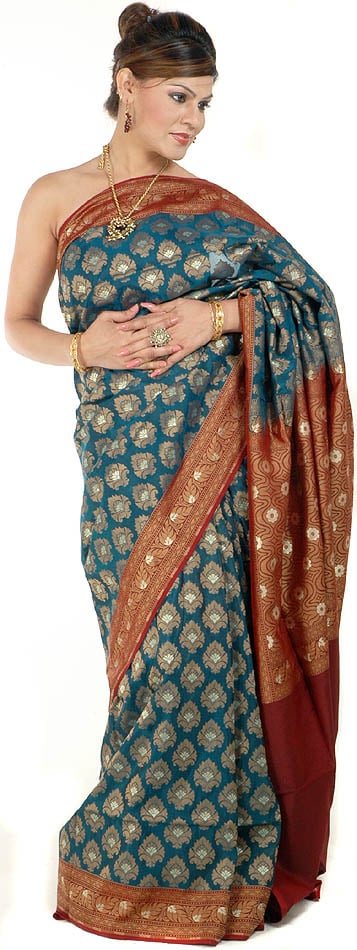Banarasi Sarees Biography
Source:- Google.com.pk
Banarasi saris are saris made in Varanasi, a city which is also called Benares or Banaras. The saris are made of finely woven silk and are decorated with intricate design, and, because of these engravings, are relatively heavy.
Their special characteristics are Mughal inspired designs such as intricate intertwining floral and foliate motifs, kalga and bel, a string of upright leaves called jhallar at the outer, edge of border is a characteristic of these saris.Depending upon the intricacy of designs and patterns, a sari can take from 15 days to a one month and sometimes up to six months to complete.
Banarasi saris are mostly worn by Indian women on important occasions such as when attending a wedding and are expected to be complemented by the woman's best jewelry.Ralph Fitch (1583–91) describes Banaras as a thriving sector of the cotton textile industry. The earliest mention of the brocade and Zari textiles of Banaras is found in the 19th century. With the migration of silk weavers from Gujarat during the famine of 1603, it is likely that silk brocade weaving started in Banaras in the seventeenth century and developed in excellence during the 18th and 19th century. The sari making is a cottage industry for about 12 lakh (1 lakh is 100,000) people associated directly or indirectly with the handloom silk industry of the region around Varanasi encompassing Gorakhpur, Chandauli, Bhadohi, Jaunpur and Azamgarh districts. Over the years, the Banarasi silk handloom industry has been incurring huge losses because of competition from mechanised units producing the Baranasi silk saris at a faster rate and at cheaper cost, another source of competition has been saris made of cheaper synthetic alternatives to silk.
Bari bazaar in Varanasi, India, is famous for banarasi silk sarees, it has come under the police station of Jait pura. It used to be known as the main handloom saree manufacturing area but times change and it has become fully powerloom sarees manufacturing area. In this particular area there are more than 10 localities served, and population is more than 1 million. In Bari bazaar, daily money transaction is probably 50 million rupee. Bari bazaar is famous for its unique design, that is why it is still in the forefront of the developed textile market (Surat, Mumbai, Kolkata). There are four main varieties of Banarasi sari, which includes pure silk (Katan), Organza (Kora) with Zari and silk; Georgette, and Shattir, and according to design process, they are divided into categories like, Jangla, Tanchoi, Vaskat, Cutwork, Tissue and ButidarSaris are woven with one plain end (the end that is concealed inside the wrap), two long decorative borders running the length of the sari, and a one to three-foot section at the other end which continues and elaborates the length-wise decoration. This end is called the pallu; it is the part thrown over the shoulder in the nivi style of draping.
In past times, saris were woven of silk or cotton. The rich could afford finely woven, diaphanous silk saris that, according to folklore, could be passed through a finger ring. The poor wore coarsely woven cotton saris. All saris were handwoven and represented a considerable investment of time or money.
Simple hand-woven villagers' saris are often decorated with checks or stripes woven into the cloth. Inexpensive saris were also decorated with block printing using carved wooden blocks and vegetable dyes, or tie-dyeing, known in India as bhandani work.In modern times, saris are increasingly woven on mechanical looms and made of artificial fibres, such as polyester, nylon, or rayon, which do not require starching or ironing. They are printed by machine, or woven in simple patterns made with floats across the back of the sari. This can create an elaborate appearance on the front, while looking ugly on the back. The punchra work is imitated with inexpensive machine-made tassel trim.
Hand-woven, hand-decorated saris are naturally much more expensive than the machine imitations. While the overall market for handweaving has plummeted (leading to much distress among Indian handweavers), hand-woven saris are still popular for weddings and other grand social occasions.
Banarasi Sarees Silk Sarees Collection For Wedding Online Shopping Blouse Designs with Price Designs in chennai for Engagement Blouse Back Designs Photos
Banarasi Sarees Silk Sarees Collection For Wedding Online Shopping Blouse Designs with Price Designs in chennai for Engagement Blouse Back Designs Photos
Banarasi Sarees Silk Sarees Collection For Wedding Online Shopping Blouse Designs with Price Designs in chennai for Engagement Blouse Back Designs Photos
Banarasi Sarees Silk Sarees Collection For Wedding Online Shopping Blouse Designs with Price Designs in chennai for Engagement Blouse Back Designs Photos
Banarasi Sarees Silk Sarees Collection For Wedding Online Shopping Blouse Designs with Price Designs in chennai for Engagement Blouse Back Designs Photos
Banarasi Sarees Silk Sarees Collection For Wedding Online Shopping Blouse Designs with Price Designs in chennai for Engagement Blouse Back Designs Photos
Banarasi Sarees Silk Sarees Collection For Wedding Online Shopping Blouse Designs with Price Designs in chennai for Engagement Blouse Back Designs Photos
Banarasi Sarees Silk Sarees Collection For Wedding Online Shopping Blouse Designs with Price Designs in chennai for Engagement Blouse Back Designs Photos
Banarasi Sarees Silk Sarees Collection For Wedding Online Shopping Blouse Designs with Price Designs in chennai for Engagement Blouse Back Designs Photos
Banarasi Sarees Silk Sarees Collection For Wedding Online Shopping Blouse Designs with Price Designs in chennai for Engagement Blouse Back Designs Photos
Banarasi Sarees Silk Sarees Collection For Wedding Online Shopping Blouse Designs with Price Designs in chennai for Engagement Blouse Back Designs Photos







No comments:
Post a Comment